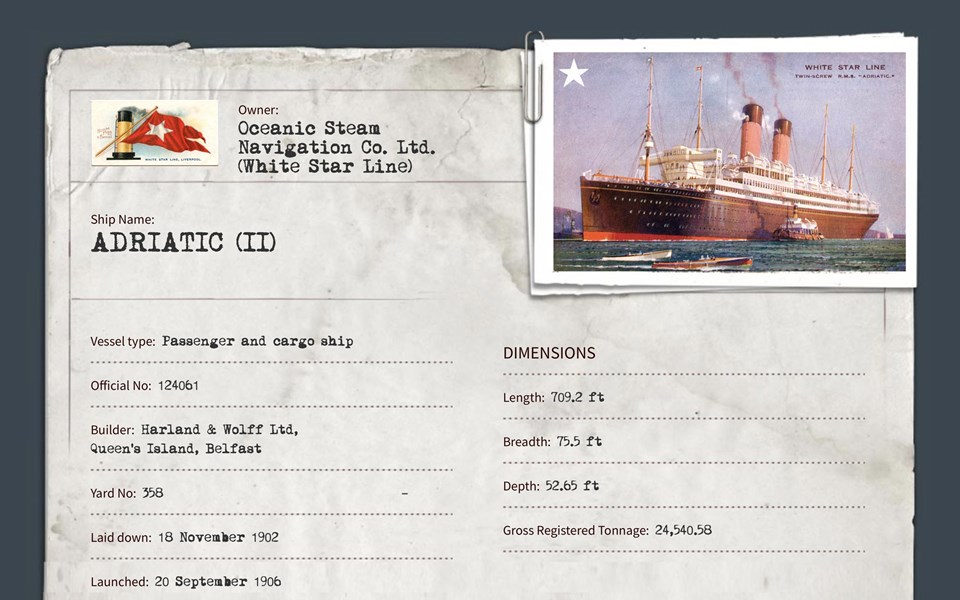Adriatic (II)
Owner: Oceanic Steam Navigation Co. Ltd. (White Star Line)
Ship Details
Details
Vessel Type: Passenger and cargo ship
Official No: 124061
Builder: Harland & Wolff Ltd, Queen's Island, Belfast
Yard No: 358
Laid down: 18 November 1902
Launched: 20 September 1906
Handed over: 25 April 1907
Port & Date of Registry: Liverpool, 23 March 1907
Managing Owner & Address: Harold Arthur Sanderson, 30 James Street, Liverpool
Description
Number of Decks: 5
Number of Masts: 4
Rigged: Schooner
Stern: Elliptical
Build: Clencher
Framework & Description of Vessel: Steel
Number of Bulkheads: 11
Number of water ballast tanks: 14
Dimensions
Length: 709.2 ft
Breadth: 75.5 ft
Depth: 52.65 ft
Gross Registered Tonnage: 24,540.58
Machinery
Engine Builder: Harland & Wolff Ltd, Belfast
Engine Type: 2 X inverted direct acting quadruple expansion surface condensing
Cylinders: 2 X 35½; 2 X 51; 2 X 73½; 2 X 104 inches
Stroke: 63 inches
Nominal Horse Power: 2,770
Boilers
Description: Cylindrical multi-tubular
Number: 8 double & 4 single ended
Iron or Steel: Steel
Pressure when loaded: 210 lbs
Screw: Twin
Speed: 17 knots
Signal Letters: H. K. N. W.
NOTES
Adriatic was the largest British twin-screw vessel when she entered service. Last of White Star's 'Big Four' - Celtic (Yard No. 335), Cedric (Yard No. 337), Baltic (Yard No. 352) and Adriatic - she was the prototype for the next generation of huge passenger liners; many White Star ‘first’ incorporated in her interior design became standard features in many of the world's leading passenger liners.
For the first time in a White Star liner passengers had a choice of either using the main companionway or an electric lift to explore the ship. The lift, or elevator, opposite the entrance to the Lounge descended four levels to the Saloon Deck. Of all the public rooms in the ship the Dining Saloon was by far the outstanding feature in the new liner. Adriatic was the first vessel to provide passengers with separate dining tables in First Class, rather than the long bench-style tables used in the past. The elaborately carved mahogany armchairs, on revolving cast-iron bases, were still securely bolted to the deck, but the tables were provided with attractive electric lamps and the overall effect was far more pleasing than that which had gone before. The Saloon extended the full width of the ship and was decorated in a Jacobean style with carved wall panelling painted ivory white - the overall impression was of a light and airy space. The main design feature was the dome, filled with leaded glass in white and yellow, through which daylight filtered into the room. A frieze beneath featured oil paintings representing scenes in Switzerland, Italy, along the Rhine and in Yellowstone Park, places that many passengers’ might expect to see on the Grand Tour. The 400 diners were the first in a British ship on the North Atlantic to be treated to the services of a professional musicians. Formally, a band composed of stewards would play for passengers, then rush off to serve meals or make up beds. The German and French lines employed professionals and, in line with the competition, the Company engaged the services of C. W. & F. N. Black of 14 Castle Street, Liverpool, a well-known music agency, to provide them with the best musicians to play in Adriatic, many having previously performed in some of London’s most fashionable hotels.
Another new feature in the ship was a large Gymnasium, equipped with a variety of strange looking exercise machines including electric camels and a rowing machine. Leading off this room was a saltwater Plunge Bath with fresh water shower cubicles, the first in an Atlantic liner and Turkish Baths with the usual shampooing, hot, temperate and cool rooms and three further rooms containing massage couches and electric baths. All these features were later incorporated in the ‘Olympic’ class.
Adriatic, when she entered service, reflected the zeitgeist; a new age in ocean travel had dawned and this vessel was the first of many to equal or exceed the facilities offered by many of the best hotels in Europe. More that any of her predecessors, she marks a crossover point in the history of the steamship and in the development of the White Star Line. Before Adriatic had a chance to prove herself in service the managers at the Company’s head office in Liverpool instructed Harland & Wolff to proceed with the design and construction of the largest liner in the world; such was their faith in the untried vessel that the order for Yard No. 400 was placed nine days before Adriatic departed on her maiden voyage.

